THE HEART UNDERGOES
A DENSE TRANSFORMATION
WITHIN A LESS THAN
A MINUTE DESCENT.
わずか1分足らずの滑降に濃密な心の動きがある。
INTERVIEW 01
SKIER
ビッグマウンテンに挑む
天才アルペンスキーヤーの未来。
「 引退という捉え方はしていないんです。なぜならビッグマウンテンスキーは、アルペンを引退した人間が挑めるような世界ではないですから」
日本人としてもっとも活躍したアルペンスキーヤー、佐々木明が選んだのは、より自由な世界だった。身ひとつでスキーを背負って山に登り、自分自身を表現するようにラインを決めて、観客も誰もいない崖を滑り降りる。コンマ1秒の単位でスピードを競うスキーではなく、時に命を賭すことさえ求められるビッグマウンテンスキーこそ、究極だという思いがある。
「 最初に行ったのが、北海道の富良野岳の横にあるホコ岩シュートっていうところで、パッと見は全然余裕じゃんって。でも実際にその場に立って見ると、身体を横に並べてふたり分くらいの幅しかない。まったく知らない規模感だったんです。その時に、所詮アルペンは規制された世界だったんだと思ったら、急に恥ずかしくなっちゃって(笑)。それまではアルペンこそが、世界最高峰で究極に難しいものだと思っていたのに、すげー小さな世界でスキーをしてたんだなって気づかされたんです」
初めてのホコ岩シュートで、佐々木は転んでしまい、細い岩の間をどうにかギリギリ滑落せずに麓まで辿り着く。苦労して登りながら、ミスしてしまったところに追い討ちをかけるように、同行していた日本を代表するビッグマウンテンスキーヤーである佐々木大輔から「アルペンスキーヤーって大したことないじゃん」と言われてしまう。それが、20歳のときの経験だった。
「 今までスキーをしてきた中で、そんなこと言われたことなかったから。小さい頃からトップでやってきて、同年代の世界ランキングでもどんなに悪くても3番までしか下がったことがない。調子に乗ってしまうだけの材料が自分の中で整っていたのに、あの一本で、あの大ちゃんのひと言で、目が覚めた。俺、スキーめちゃくちゃヘタクソだと思ったんです」
だからこそ、ビッグマウンテンスキーの世界には、「帰って来た」という感覚さえある。「オリンピックに優勝してから、ワールドカップに勝ってから、本格的にビッグマウンテンスキーへ」という思いでアルペンを続けていたが、32歳になってよりフィールドを広げる決断をした。
「 勝つ前に行ってしまったから、逃げみたいに感じるかもしれないですけど、スキーの一線から退いた人間ができることではない。だって究極じゃないですか。雪山を登る知識、天候、地図、学ぶことがアルペンの100倍以上ある。アルペンは誰かがセットした場所をヨーイドンで滑るだけ。ミスしても、横は整備されている。でもビッグマウンテンは、あっ! って言ったら岩にゴーンですから。絶対に命をかけてはいけないんですけどね。でも矛盾するようだけど、その部分で刺激を感じてしまうし、ドキドキする。最高のラインを滑ったときの、自分が上にいた時と下にいる時の、心の差っていうのかな。たかが30~40秒、長くて1分の中に、これだけ心の変化が凝縮されることは、もちろん日常生活にもないし、アルペンにもなかったから」 アルペンではアドレナリンだけが放出されて、興奮状態が続いていたのに対し、ビッグマウンテンでは、極度の興奮と緊張に続いて、安堵感がやってくる。猛スピードの感情変化は、その一瞬がいかに濃密なものであるかを物語る。
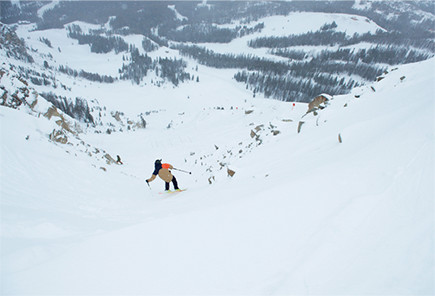
NEIL HARTMANN
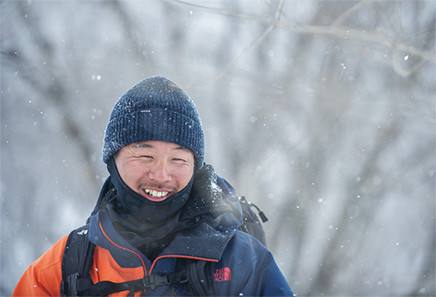
HIROYA NAKATA
スキーヤーが選んだ
新しい生活は、旅の中にこそ。
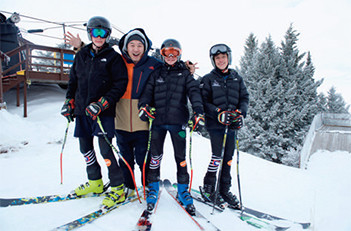
HIROYA NAKATA
かつてレースに出場していた時は、1年間を細かく区切り、アスリートとしてのライフスタイルを確立していた。1戦目が始まるまでに、「自分が何ターンしたら、どこまで調子が上がる」かが分かるほどの時間の刻み方。その細かなスケジューリングの対極にある現在の雪山を求める“旅の生活”は、どんなものなのか。
「 去年1年間は、インスペクション、いわば下見の年でした。どんな風に自分の時間を組み立てればいいのか、とにかく動いた1年。それに、できるだけスキーをして、自分がどれくらいスキーが好きなのかも確認したかった。『やっぱり大好きでした』っていうのが、1年間の答えだった」旅には、ルールがひとつだけあって、それは日本からカメラマンを連れて行かないということ。必ず、現地調達することにした。なぜなら、スキー界での立ち位置や知名度を含めた、自分の実力がハッキリと分かるから。
「 まずはキャッチーなスキー場に行って、フリーライドしているそれっぽいビッグマウンテンをやってそうなヤツをリフトに乗りながら探すんです。板もまあまあだし、ビンディングのセッティングも本気だなと。あいつが一番うまいから、一緒にリフトに乗ってやろうとタイミングを徐々に合わせていくんですよ。俺が滑っているのもきちんと見せて。一緒にリフトに乗って、『日本から来たの?』って話しかけられたら、シメたもの。『アルペンスキーやっててさ』と少しずつ話を誘導して、『名前、調べたら出てくるんじゃね?』って(笑)。『お前、スゲーじゃん!』ってなった瞬間に、『実は撮影したくてさ』と話を持っていく。仲間を紹介して欲しいって。ちなみに、泊まる場所もないって(笑)」
そうやって自分の名前を使いながら、現地でコネクションを作り、新たな友と山へ登って、美しいラインの記録を残していく。
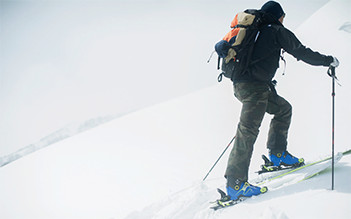
HIROYA NAKATA
2年に1本のペースで映像を作り、6年間の3本で、「なぜ、あの時にアルペンをやめたのか」を一般の人にまで分かってもらえればいいと考えている。ワールドカップやオリンピックを捨てなければ、到達できない世界があることを、身体能力が充実している間に、映像表現として残していく。
「 “佐々木 明”っていう名前が使えたのも、去年1年だけですから。それは誰よりも分かってます。これからは、“過去の人”だって見られる訳です。でも、俺には地続きの話ですから。
自分が見ていて輝いている人って、常に次の挑戦の話をしている人なんです。自分もそうありたいなと思ってる」
ビッグマウンテンに挑む佐々木明は、野性味を増している。「例え馬鹿なヤツだと思われようと、感情を揺さぶっていることには違いない」と語る姿には、スキーへの愛情と野望、そして自信が滲んでいた。
1981年北海道北斗市(旧大野町)
出身。3歳でスキーを始め、16歳でアルペンスキーの日本代表に選出。ソルトレーク、トリノ、バンクーバー、ソチと4度のオリンピックに出場。ワールドカップでは、3度の2位を記録している。ヨーロッパではファンクラブが作られるほど、そのスタイルに評価が高い。2011年にはNPO「Skiers Help Foundation」を立ち上げ、被災地のスキーヤーや子どもたちの支援を行っている。現在は、世界各国のビッグマウンテンを渡り歩く旅の生活をしている。
【世界選手権】
2001年:St.Anton(AUT)
2003年:St.Moritz(SUI)
2005年:Bormio(ITA)
2007年:Are(SWE)
2009年:Val d Isere(FRA)
2011年:Garmisch Partenkirchen(GER)
2013年:Schladming(AUT)
【オリンピック】
ソルトレイクシティ、トリノ、
バンクーバー、ソチ
【ワールドカップ】
出場回数143レース、
Top10:21回(日本人最多)
Top30:49回(日本人最多)
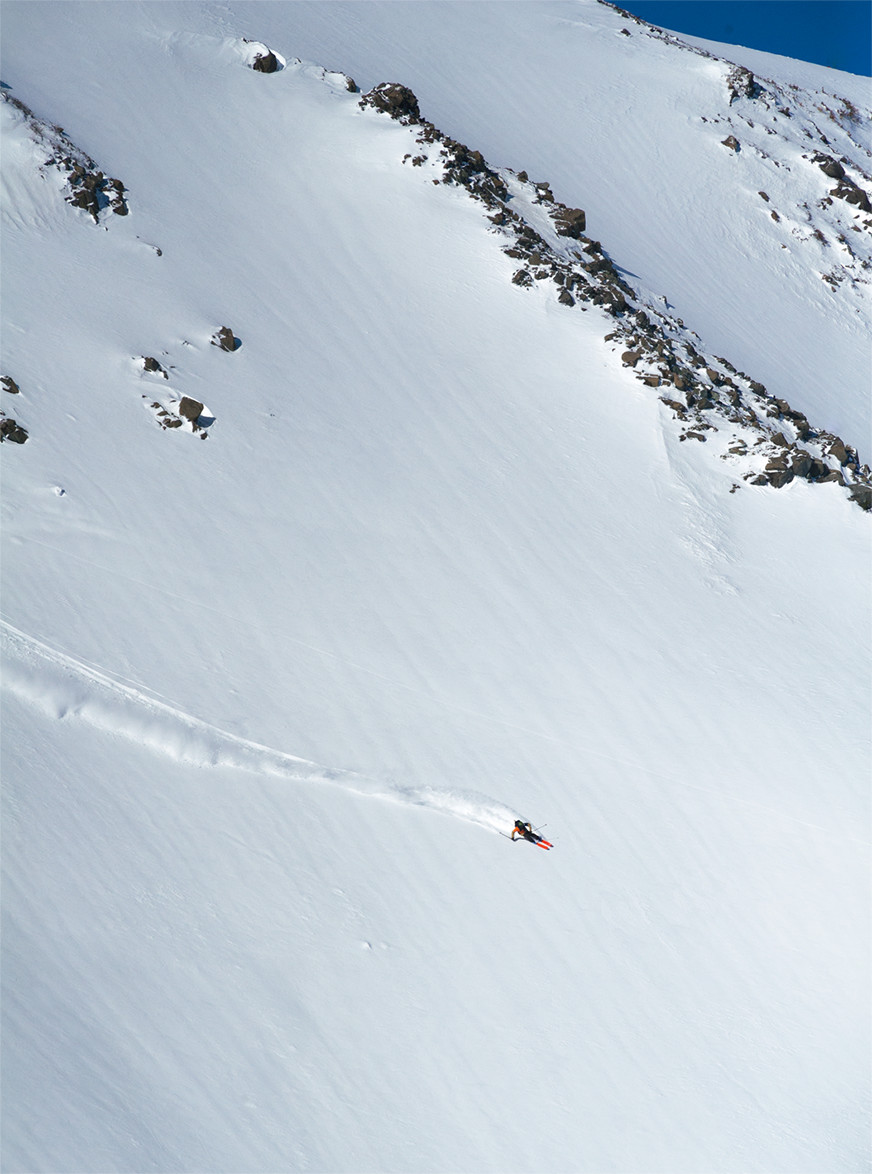
HIROYA NAKATA
The future of a genius alpine skier constantly
challenging the big mountain
“I do not consider myself retired. The world of big mountain skiing is not a world that a retired alpine skier can take on.”
The world that Japan’s number one alpine skier Akira Sasaki chose is one that is much more free. You carry your skis on your back and climb the mountain, you choose a line that expresses yourself, and without anyone watching you, you descend the cliffs of the mountain. It is not a type of skiing where you battle for every tenth of a second, you could say that big mountain skiing is an ultimate ski form in which you occasionally find yourself risking your very life. “For my fi rst time I went to the Hoko Iwa chute just outside Furano in Hokkaido. At fi rst glance I thought it would be a piece of cake. But standing there in person, it was a chute no wider than two people’s length.
I couldn’t even grasp the scale of the slope. After all, alpine skiing is a controlled world and I suddenly felt embarrassed to be there. Until then, I thought I was skiing in the ultimate pinnacle of the ski world, but I realized just how small of a world I was actually skiing in.”
On his fi rst run on the Hoko Iwa chute, Sasaki fell and barely managed to escape falling between a narrowshaft and eventually ended up reaching the bottom safely.
While climbing back up the mountain, his companion Daisuke Sasaki, a Japanese professional big mountain skier, and as if to attack an already downed enemy, said to him, “I guess alpine skiers aren’t all that much.” This was when he was twenty years old.
“In all my time skiing I had never been told that. I was able to rise to the top from a young age, and at worst, my world ranking only ever dropped to 3rd. I was set with my cocky attitude, but in just that one run, and with that one comment from Daisuke, it was all fi nally clear.
I knew I was a crappy skier.”
This is why there is a feeling of “I have returned”, in regards to big mountain skiing. He originally had the intention to devote himself to big mountain skiing after winning the Olympics or the world cup, however, upon turning 32 years of age, he set out to expand his fi eld.
“It might look like I had run away since I quit before I won, but this is not something a ‘quitter’ can do.
I mean this is the ultimate form of skiing. The amount you have to learn, from how to climb the mountain, read the weather, maps, etc., is 100 times more than what is required in alpine skiing. With alpine skiing, you ski a line set by man at the sound of a ready – set – go. If you fall,
the edge of the course is guarded. With big mountain skiing, if you make a mistake, you are surrounded by boulders. You are risking your very life. But this is what you live for, what excites you. When you ski the perfect line, the change in your heart is the same as the change from the top to the bottom of the line. At most, it only lasts 30-40 seconds, maybe a minute, but in this short time your heart transforms. It is a feeling that does not exist in every day life and it did not exist in alpine skiing.”
In alpine skiing, a sense of excitement continues on throughout the course, but with big mountain, you feel a more ultimate form of excitement and nervousness,
and on top of that, a sense of calmness and relief.
It is such a fast speed that your emotions change at the same fast pace and he lets us know more about those deep emotions felt in those short instances.
The new life that a skier chose is a life of travel.
In his racing years, he adopted a lifestyle of a true athlete where his entire year was planned to perfection.
Before the fi rst race he analyzed every aspect and new which turns would produce the best results. And we wonder, just what kind of “travel life” exists at the opposite end of his previously lived scheduled life.
“Last year was a preview, or inspection. It was so I could understand how I should arrange my time.
In any case, I kept moving around. I just kept skiing, as I wanted to confi rm just how much I loved it. The answer to my 1 year of travel was, ‘yep, I love this sport.’”
There was one rule while traveling and that was to not bring a cameraman from Japan. Always procure one locally. He knows very precisely his ability and has a certain status and familiarity among the ski world.
“I would go to a popular ski resort and free ride while searching for someone that appears to ski big mountain.
I would fi nd someone with good skis and bindings and gradually work it so we would be on the same lift.
I would also make sure to let them see me ski. I wanted them to ask, ‘are you from Japan?’ I would say that I am an alpine skier and tell them to search for me on the Internet. ‘Wow!’ they would say, and in that moment I would let them know that I am looking to fi lm and get them to introduce me to someone. I also often let them know that I had no place to stay, haha.”
He would use his name to make new connections and friends in each new location, climbing new mountains and creating memories of new lines. Making one fi lm every two years for a total of three fi lms in six years, he wanted to help people understand why he left alpine skiing. While perfecting his physical condition, he leaves behind a video record of a world that exists and obtainable only by abandoning the idea of the Olympics or world cup.
“It was only for a years time last year that I was able to use the name ‘Akira Sasaki’ to my benefi t. From now on, that person is a person of the past. I am already transitioning to a new land. The person that I see is a person that is already onto the next big challenge. And this is exactly what I want.”
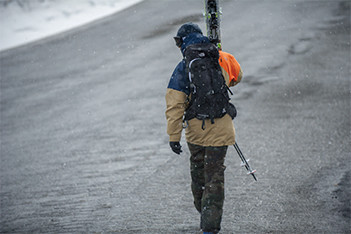
HIROYA NAKATA
Challenging the big mountain, Akira Sasaki is increasing his touch on the wild. “Even if people think I am crazy,
they cannot say I am not stirring up emotions.” His love and ambition for skiing, and his confi dence certainly flow abundantly.
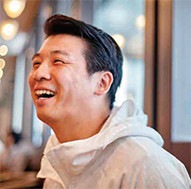
TAKESHI ABE
Born in 1981 in Hokuto city Hokkaido. Started skiing at the age of 3 and selected as a Japan team member for alpine skiing at the age of 16.
Participated in the Salt Lake, Torino, Vancouver, and Sochi Olympics. Took 2nd place in two world cup appearances.
Possessing a respected style, even his own personal fan club was created in Europe.
He founded the NPO“ Skiers Help Foundation” in 2011 to support the skiers and children of the devastated region.
He currently lives a traveler’s life visiting countries worldwide to ski big mountain.